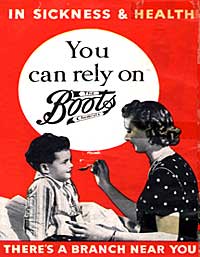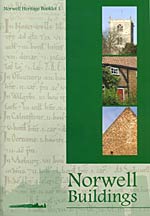News

Boots 1849-2009. Dispensing Feel Good Formulas
Wednesday, 9 September - Sunday 22 November
Weston Gallery, D.H. Lawrence Pavilion, University Park, University of Nottingham
The Autumn exhibition contains much of local interest. It celebrates 160 years of Boots' history, drawing chiefly on the Boots Archive and Museum collections, complimented by University archives. It has been curated by the archivists at Boots in partnership with The University's Manuscripts and Special Collections department.
The first Boots shop opened on Goose Gate in Nottingham in 1849. Originally a small herbalist store providing affordable family remedies, the business grew through the vision and drive of Jesse Boot to become a household name with local pharmacies across the country. Now a global brand, Boots has retained a strong association with Nottingham's community - both as a major employer and through its long tradition of charitable giving.
The display charts the company's origins and growth. It explores Boots' pharmacy heritage as well as the development of its beauty brands. The company was a pioneer in employee welfare, and the exhibition focuses on the people, recording social and sporting events, descriptions of working conditions and recollections from past employees.
The story of Jesse Boot's philanthropy to Nottingham is linked to the history of the University of Nottingham. University archives show Boot's close interest in the development of the campus and the public facilities which followed his gift of the Highfields estate to the city.
A series of talks and events will be held to accompany the exhibition. A special workshop will be held for members of the public who would like to share memories of working at Boots. For further information see the Lakeside Arts On brochure, or contact Manuscripts and Special Collections at the University: tel: 0115-951-4565 or email mss.library@nottingham.ac.uk.
Lunchtime talks, 1pm - 2 pm. Admission Free but book places in advance on 0115-846-777 Venue is the Performing Arts Workshop.
Wednesday 23 September: A Family Business. Sophie Clapp (Boots Archives) will provide a history of Boots and the Boot family using images from the company archive.
Wednesday 14 October: Unlocking the Past. Discover how the Boots archive collection is used to support present day business activities. The Boots Archive team will discuss how the Boots heritage is kept alive and will bring along some unusual items from the collection.
Wednesday 11 November: Boots: A Business Within the Community. Boots' record of community giving spans over two centuries, Charlotte McCarthy (Boots Archives) outlines some of the many donations made by Boots to the people of Nottingham. Oonagh Turnbull, Head of Corporate Social Responsibility, Boots UK will also highlight some current local initiatives.
Thursday 8 October: Collecting Memories of Boots. A Workshop for adults (over 18 years) 1.30 pm - 4.30 pm. Venue and booking as above.
Do you have memories of working in Boots factories or shops, or as a Boots customer? Join writer Andy Barrett and Sophie Clapp for afternoon tea and some 'memory collecting'. Afterwards, your recorded anecdotes will be transcribed and added to the Boots Company Archive for posterity.
A Century of Fatherhood
Testimony Films, based in Bristol, are seeking stories for a television series charting A Century of Fatherhood to be shown on BBC4 in 2010. They particularly seek stories from the older generation reflecting their role as fathers as well as hearing from fathers who left their families to fight in the Second World War and from the children they left behind. A further interest is in fathers of the 1960s to find out how the sexual revolution affected traditional family life.
Testimony Films has a track record of making oral history documentaries, they interviewed Harry Patch about his WW1 memories when he was 98. For further information visit
www.testimonyfilms.com and anyone interested in contributing should contact researchl@testimonyfilms.com
(Ed: Harry Patch sadly died 25 July 2009 - he was born 17 June 1898)

VCH Nottinghamshire
The Victoria County History (VCH) started in 1899, and with a burst of local enthusiasm produced two Nottinghamshire volumes in 1906 and 1910. The proposed topographical volumes (parish histories) were part researched but never written up, and they remain incomplete. In the East Midlands only Rutland was finished, but in recent years work has resumed in Derbyshire, Leicestershire and Northamptonshire, and now Nottinghamshire Libraries and Archives have taken an initiative designed to revive work locally. For the next two years, working in partnership with the Thoroton Society, the Nottinghamshire Local History Association, and the University of Nottingham, they are going to provide support for Mr. Philip Riden (currently VCH Derbyshire county editor, and previously at VCH Northamptonshire) to work for one day a week setting up one or more research groups to start work on parishes in the county.
An open meeting is being called at Nottinghamshire Archives on Tuesday, 15 September 2009 at 6.30 pm to explain the project and what is intended. We are inviting representatives of research and local history groups, the WEA, interested individuals, and key county council personnel to come and hear about the VCH, the Nottinghamshire project, how to become involved, and what to expect! The meeting will be hosted by Mr. Mark Dorrington, Principal Archivist, and addressed by both Mr. Riden and Professor John Beckett, who is both Chair of The Thoroton Society and Director and General Editor of the VCH. If you, or a member of your group, would like to attend, please email or phone Jean Stanbridge: jean.stanbridge@nottscc.gov.uk; 0115-950-4524
The Thoroton Response Group
One of the most recent representations made by the Thoroton Response Group on the Society's behalf concerned the announcement of museum closures by the City Council. A letter was sent to the Leader and the appropriate Portfolio Holder, as well as the Chief Executive and responsible officers.
In it attention was drawn to the wider importance of museums, especially in a city which is trying to increase educational attainment.
We said 'in view of the City Council's commitment to improving the educational opportunities of its young people, the value of a vibrant and wide ranging heritage offer cannot be overestimated. Not only does it broaden the possibilities for learning but also gives a sense of the continuity of City life and pride in its past; important for community cohesion and respect, which we know that the Council is aiming to promote. Hardly less important is that the tourist industry cannot expect to attract visitors to the City if it has limited and ill resourced venues.' We went on to commend work achieved and supported, especially at Wollaton Hall, but we said 'there is so much more which is of interest in Nottingham - it has such a tremendous history which is largely untapped in interpretative terms - it is a City of Caves, of Lace, of radicalism, of brilliant architecture, of industry'.
We urged the Council 'to be visionary and seek to enhance the City's cultural heritage, to preserve and celebrate the long and proud history of Nottingham, Nottingham's people and their achievements through the centuries'.
We have received a response from the Portfolio Holder but without any commitment to change policy in this area.
The other matter responded to was English Heritage's survey entitled Conservation Areas at Risk and if you have comments you wish to make on your local conservation area go to www.english heritage.org. uk/conservationareas.
As yet, members have not raised matters which they wish the Response Group to consider -please, if you have concerns regarding building or land use changes in the county, let us know.
On behalf of the Society we responded to the findings of English Heritage's Conservation Areas at Risk survey by writing to all those local authorities in Nottinghamshire who had been found to have conservation areas suffering neglect or degradation. The main causes for concern identified by English Heritage were changes made by owners, such as UPVC windows and doors and poor, unsympathetic or neglected environmental and highway works by the responsible councils.
Our letters dated 1 July were sent to Bassetlaw with two CAs at risk (no response to date, Gedling also with two CAs at risk (no response to date), Mansfield with four CAs at risk (no response to date), Newark and Sherwood with 5 CAs at risk and Nottingham City with 12 at risk.
We set out our concerns and asked that the authority do all in its power, including the use of Article 4 Directions and careful consideration of environmental and highway factors, to preserve our delicate and finite heritage for future generations to appreciate and enjoy.
The Leader of Nottingham City Council responded and referred to the City Centre Urban Design Guide which was produced 'to promote and enhance our historic city core'. He says that 'securing good quality development appropriate to its [the city's core] context is an underlying principle of the document'. He also speaks of the Streetscape Manual setting 'the standard for changes to the streetscape within conservation areas and elsewhere' and recent CA appraisals and management plans. These measures are said to demonstrate 'commitment to place-making and the importance attached to the city's heritage.'
The Leader of Newark and Sherwood shares the Society's concerns and comments on the limited financial input that the LA can make available to owners of CA buildings and informs us that their Principal Conservation Officer is enquiring about the specifics of the problems identified by English Heritage. We are promised to be informed of the outcome.
Barbara Cast
NORWELL PARISH HERITAGE GROUP
John Beckett

The Norwell Group, convened by Elizabeth Jones, is a shining example within Nottinghamshire of what can be achieved by a small group of committed volunteers working intensively on a parish project, with a relatively small amount of financial support from the Heritage Lottery Fund.
On 16 May the group launched the first three of a proposed (initial) five booklets on the history of aspects of the village These cover the village buildings, mills and trades, and each is a model in itself, combining detailed historical research with clear explanation and excellent illustrations. Local and wider contexts are also explained in each case. I particularly enjoyed the study of Norwell trades, not just because of clear description, but because it shows how a village only a mile or so from the Great North Road, remained largely self-contained in terms of necessary crafts and skills, until the agricultural depression of the later nineteenth century.
Each booklet costs £4, and we hope to have them available on the Thoroton book stall at autumn lectures. Alternatively, copies are available at £4 each plus postage. Please contact the Secretary, NPHG: 01636-636365 or email at emjones.norwell@btinternet.com.
Powerhouses of Provincial Architecture, 1837-1914.
ed: Kathryn Ferry (2009)
ISBN 978-0-901657-37-4
Review by Terry Fry
This attractive book is published by The Victorian Society and is based on its symposium held in January 2008 at the Society of Antiquaries in London. Six experts look at the way architects with considerable local influence give a distinctive character to urban landscapes in the Victorian and Edwardian periods. Ronald Perry writes about Sylvanus Trevail's whirlwind career in Cornwall where he took on 300 commissions in 30 years, including the Atlantic Hotel at Newquay, then shot himself at the age of 52. Pevsner said that he was one of the more original Victorian architects. That could also be said of Watson Fothergill: a Provincial Goth as Ken Brand calls him in his informative chapter on those familiar, but still remarkable, buildings of Fothergill's in Nottingham.
Kathryn Ferry praises John William Cockrill for transforming Great Yarmouth 'from a fishing port to one of the most attractive seaside resorts'. For Sarah Whittingham, the Pride of Bristol is Sir George Herbert Oatley, whose outstanding Wills Memorial Building for Bristol University graces the front cover.
David Summers introduces the work of George John Skipper, a Norfolk architect who designed outstanding buildings in Norwich, such as the Royal Arcade and Surrey House. Unfortunately, his beautiful Hotel Metropole at Cromer was demolished in the 1960s and replaced by 'a building devoid of any architectural merit'. Sound familiar? Geoff Brandwood writes about the many fine churches built by the Lancashire partnership of Edward Paley and Herbert Austin, especially the very best; St. George's, Stockport.
All these men resisted the lure of London and invested the provinces with their talent. Like many eminent Victorians they drove themselves hard and, with the exception of Trevail, until late in life; Skipper was still working at the age of 91.
This is a well-produced book, enhanced by many good photographs and a suitable bibliography.
Plenti and Grase: Food and drink in a sixteenth century household
Mark Dawson, Prospect Books, 2009
Members will recall Mark's lecture to the Society last autumn and, of course, the article based on the lecture which was published in Transactions.
Mark's book is now published and available at Waterstones and from Amazon at £30.
By the time this Newsletter is read the book should also be available at Wollaton Hall.
Miscellaneous news
The Annual Lecture for the Friends of St. Mary's is to be given by Professor John Beckett on Sunday, 18 October at 7.30 pm after 6.30 Choral Evensong. The subject is The Lost Churches of Nottingham. Members of The Thoroton Society will be most welcome.
Professor John Beckett represented The Society at a packed Southwell Minster on Sunday 19 July for the retirement service and presentation to Bishop George Cassidy, Bishop of Southwell. Bishop Cassidy is retiring to Somerset after ten years as Bishop of Southwell. In a farewell sermon the Bishop talked of the challenge of the post in the social and economic condition in which we live, and wished the Church of England in Nottinghamshire well in the years to come.
David Crook's latest contribution to the history of Nottinghamshire is: A Petition from the Prisoners in Nottingham Gaol, c 1330: Grace and Grievance, ed. Mark Ormrod, Gwilym Dodd and Anthony Musson (Woodbridge, 2009) pp. 206-21.
The Nottingham Mechanics holds a Heritage Open Day on Saturday 12 September 2009 from 10.00 am to 5.00 pm. This is in conjunction with Heritage Open Days and there will be displays, demonstrations and talks covering the organisations which use The Mechanics for their events. The day will be formally opened at 10.30 am with a talk on the history of the Nottingham Mechanics Institute and there will be guided tours of the building throughout the day.
Bramcote History Group extends an invitation to its Local History Societies' Fair at St. Michael's Church Centre, Church Street, Bramcote, at 8 pm on Monday, September 21, 2009. Admission is £2 and for Bramcote History Group members, £1.
The Nottinghamshire Local History Association holds its next day event at Oxton Village Hall on 24 October 2009 when the theme will be Castles.
We extend a very warm welcome to the following who have joined the Society since the last Newsletter: Rev. R. W. Breckles; Mrs. P. Cooke; Mr. J. Cruse; Mrs. P. M. Gurney;
Mr. A. Kirk; Mr. R. Malinsky; Miss N. Peterson-Tait;
Mrs. J. Shaw-Browne; Mrs. C. Wilkins.